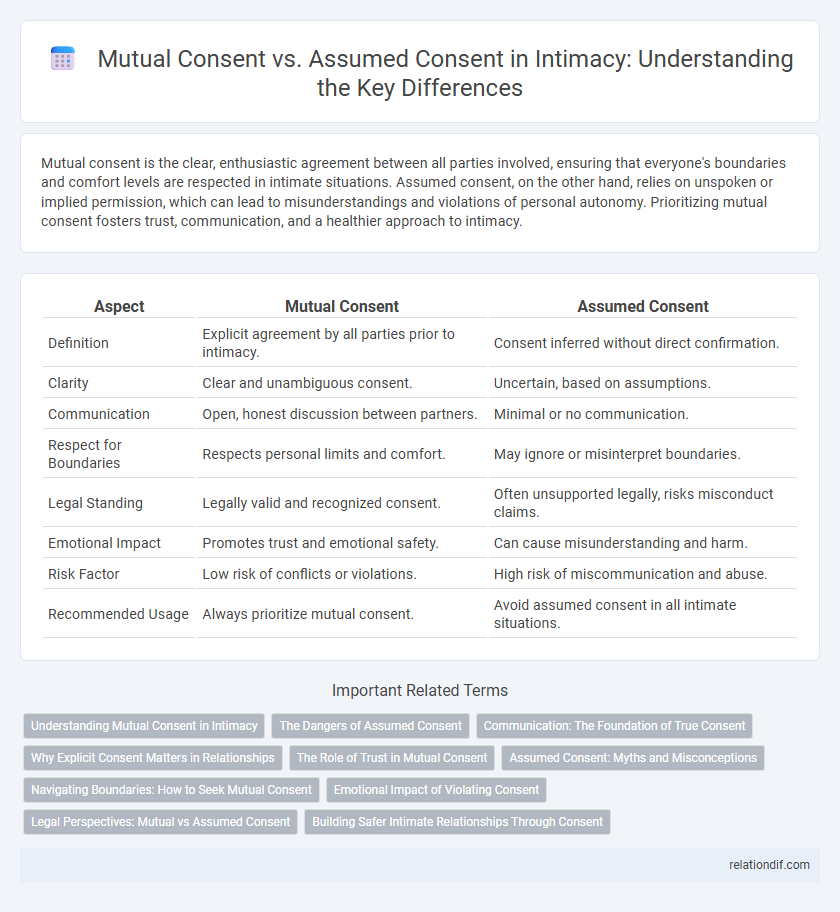Mutual consent is the clear, enthusiastic agreement between all parties involved, ensuring that everyone's boundaries and comfort levels are respected in intimate situations. Assumed consent, on the other hand, relies on unspoken or implied permission, which can lead to misunderstandings and violations of personal autonomy. Prioritizing mutual consent fosters trust, communication, and a healthier approach to intimacy.
Table of Comparison
| Aspect | Mutual Consent | Assumed Consent |
|---|---|---|
| Definition | Explicit agreement by all parties prior to intimacy. | Consent inferred without direct confirmation. |
| Clarity | Clear and unambiguous consent. | Uncertain, based on assumptions. |
| Communication | Open, honest discussion between partners. | Minimal or no communication. |
| Respect for Boundaries | Respects personal limits and comfort. | May ignore or misinterpret boundaries. |
| Legal Standing | Legally valid and recognized consent. | Often unsupported legally, risks misconduct claims. |
| Emotional Impact | Promotes trust and emotional safety. | Can cause misunderstanding and harm. |
| Risk Factor | Low risk of conflicts or violations. | High risk of miscommunication and abuse. |
| Recommended Usage | Always prioritize mutual consent. | Avoid assumed consent in all intimate situations. |
Understanding Mutual Consent in Intimacy
Mutual consent in intimacy involves clear, enthusiastic, and ongoing agreement between all parties, ensuring that boundaries and comfort levels are respected. Unlike assumed consent, which relies on perceived or implied agreement without explicit communication, mutual consent emphasizes open dialogue and affirmative confirmation. Understanding mutual consent fosters trust, safety, and respect in intimate relationships, reducing the risk of misunderstandings or harm.
The Dangers of Assumed Consent
Assumed consent in intimate situations poses significant risks, as it disregards clear communication and individual boundaries, leading to potential emotional harm and violation of personal autonomy. Without explicit mutual agreement, actions based on assumed consent can result in misunderstandings and non-consensual encounters, which undermine trust and respect within relationships. Prioritizing mutual consent ensures both parties fully understand and agree to the boundaries, fostering safety and genuine intimacy.
Communication: The Foundation of True Consent
Effective communication establishes the foundation of true consent by ensuring all parties openly express their boundaries, desires, and comfort levels, preventing misunderstandings inherent in assumed consent. Mutual consent requires explicit verbal or non-verbal agreement, emphasizing active dialogue and respect, whereas assumed consent risks violating personal autonomy and trust. Prioritizing clear, continuous communication fosters safe, respectful intimacy built on genuine agreement rather than presumption.
Why Explicit Consent Matters in Relationships
Explicit consent matters in relationships because it ensures clear communication and respect for personal boundaries, preventing misunderstandings and emotional harm. Mutual consent establishes a foundation of trust and safety, where both partners actively agree to intimacy rather than relying on assumptions. Prioritizing explicit consent fosters healthier, more respectful connections by affirming autonomy and reducing the risk of coercion or violation.
The Role of Trust in Mutual Consent
Mutual consent relies heavily on trust, as both parties must feel confident that their boundaries and feelings are respected without pressure or assumptions. Trust facilitates clear communication and honesty, ensuring that all individuals involved willingly participate with informed agreement. In contrast, assumed consent undermines trust by ignoring personal autonomy and can lead to misunderstandings and emotional harm.
Assumed Consent: Myths and Misconceptions
Assumed consent in intimacy is often misunderstood, leading to harmful myths that consent is implied by actions or prior relationships rather than explicitly given. This misconception ignores the necessity of clear, enthusiastic, and ongoing agreement between all parties, risking violations of personal boundaries. Educating about the importance of explicit consent challenges these false narratives and promotes healthier, respectful interactions.
Navigating Boundaries: How to Seek Mutual Consent
Navigating boundaries in intimacy requires clear communication and respect for personal limits, emphasizing mutual consent as a foundation for trust and safety. Seeking mutual consent involves actively asking for and receiving explicit permission before engaging in any intimate activity, ensuring both partners feel comfortable and heard. Understanding that assumed consent can lead to misunderstandings, prioritizing mutual consent fosters healthier and more respectful connections.
Emotional Impact of Violating Consent
Violating mutual consent in intimate relationships often leads to deep emotional trauma, including feelings of betrayal, loss of trust, and anxiety. Assumed consent disregards clear communication, resulting in emotional distress and confusion for the affected party. Respecting explicit mutual consent is crucial to maintaining emotional safety and healthy interpersonal connections.
Legal Perspectives: Mutual vs Assumed Consent
Legal perspectives on intimacy emphasize mutual consent as a foundational principle, requiring explicit, voluntary agreement between all parties involved to validate any intimate interaction. Assumed consent, often criticized in legal contexts, lacks clear evidence of agreement and can lead to significant legal consequences, including allegations of assault or harassment. Jurisdictions worldwide increasingly mandate mutual consent standards to protect individual autonomy and ensure accountability in intimate encounters.
Building Safer Intimate Relationships Through Consent
Building safer intimate relationships relies on establishing mutual consent, where all parties actively and explicitly agree to each interaction based on clear communication and respect. Assumed consent undermines trust and increases the risk of boundary violations, as it bypasses open dialogue and the expression of genuine willingness. Prioritizing mutual consent fosters emotional safety, strengthens connection, and creates a foundation for healthy, respectful intimacy.
Mutual consent vs Assumed consent Infographic

 relationdif.com
relationdif.com